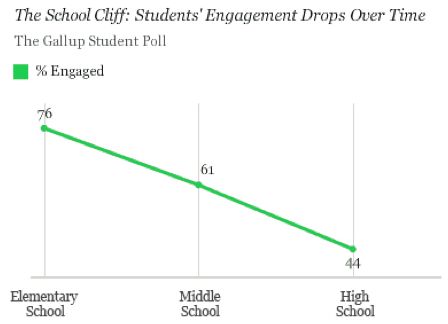 Though student engagement seems like a tough thing to measure, Gallup recently did, calling it the education version of “the fiscal cliff” so much in the news at the turn of the year. In a survey of 500,000 students in grades 5 through 12, Gallup Education found that, while nearly 80% of elementary students its surveyed “are engaged with school,” that engagement falls to 40% of high school students. “Our educational system sends students and our country’s future over the school cliff every year,” wrote Brandon Busteed, executive director of Gallup Education earlier this month. The survey used five measurements of engagement: “I have a best friend at school”; “I feel safe in this school”; “My teachers make me feel my schoolwork is important”; “At this school, I have the opportunity to do what I do best every day”; and “In the last seven days, I have received recognition or praise for doing good schoolwork.”
Though student engagement seems like a tough thing to measure, Gallup recently did, calling it the education version of “the fiscal cliff” so much in the news at the turn of the year. In a survey of 500,000 students in grades 5 through 12, Gallup Education found that, while nearly 80% of elementary students its surveyed “are engaged with school,” that engagement falls to 40% of high school students. “Our educational system sends students and our country’s future over the school cliff every year,” wrote Brandon Busteed, executive director of Gallup Education earlier this month. The survey used five measurements of engagement: “I have a best friend at school”; “I feel safe in this school”; “My teachers make me feel my schoolwork is important”; “At this school, I have the opportunity to do what I do best every day”; and “In the last seven days, I have received recognition or praise for doing good schoolwork.”
Educators Sylvia Martinez and Jackie Gerstein also blogged about the survey. In different ways, both of them wrote about how making learning participatory is key to student engagement. Sylvia calls for working with students as “participants and co-creators of knowledge.” And Jackie cited other research finding that students are engaged in both meaningful learning and social activism through their social networks outside of school. So she offers a logical solution to low engagement: increase school’s relevance by exploring what’s meaningful and relevant to students using the media they use 24/7. “If one of the goals of education is to help students become responsible citizens, then learners should be given the opportunity, skills, tools, and strategies to be active change agents.”
I completely agree – and civic engagement or social activism is a key element of digital citizenship too (see Slide 2 of this PowerPoint). Active, literate participation in their world, in and with their media accomplishes many things: opportunities to practice citizenship through engagement, not just with content, but with their fellow learners and activists and with their community (from a classroom to a school to local and global interest communities). It increases social intelligence or literacy, which also increases academic success, which prepares them for their futures. In her post, Jackie offers examples of student civic engagement, as have I in many blog posts, linking to many of them in this one about a 12-year-old New Zealander and this one about young change agents leveraging social media here in the US. There are countless examples.
Related links
- “Literacy for a digital age”
- An elementary and middle school teacher and her students “Mining Minecraft” for all kinds of learning (as told by the teacher (a series: Part 1, Part 2, and Part 3)
- “Trying out a real career in a virtual world”

[…] on https://www.netfamilynews.org Like this:LikeBe the first to like […]